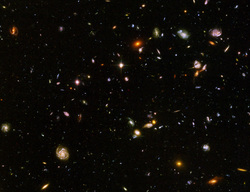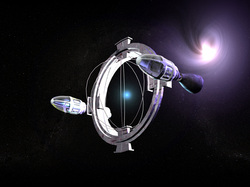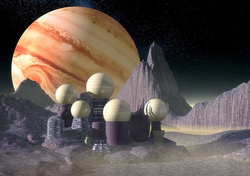The World in 2200

The average person of today is likely to spend the vast majority of their time in a virtual reality of some kind. Physical society and culture still exists - but most now eschew it, in favour of the Godlike capabilities they can experience online.
It is becoming very rare to encounter a friend or colleague in person now. In fact, you are more likely to encounter a form of artificial intelligence today, than you are to encounter a living, breathing human. Urban centres are becoming eerily deserted, with most citizens to be found in their homes, or in digital libraries and entertainment venues, engaged in complex simulations wired directly to their brains. Manufacturing industries have been entirely automated now - as well as most workplaces - with almost everyone now working from home. The Internet has evolved into what is, essentially, a gigantic global mind: transparently embedded in everything from clothing to fields of corn, from cars to space stations.
Literally everything has been automated, controlled and made easier. Take peoples' hair, for example. This no longer requires cutting by human hands: it can simply be grown according to a program of your choice. Genetic information is beamed to receivers in your neural interface, instructing the nanobots in the body to apply the appropriate style, colour or length. Precision and control is achieved on a molecular level, with the treatment completed in seconds.
Often, styles are designed by ordinary citizens, or AI, then promoted via online communities, with the best ones rated and made popular, in a manner similar to the commercial music charts of previous centuries. This same process is used for a whole host of other goods and services - from domestic pets, to gardening, to body tatoos, to gourmet food. In this way, a person can become relatively famous by modifying the genetic coding or molecular structure of different items, using the knowledge available to them online.
Technology is changing everything. It is eliminating famine, disease and the need for war, with only a handful of the most backwater nations remaining unaffected by the Singularity. These are closely monitored by the developed states, with severe penalties for any which threaten the technological progress of the rest of the world.
For the majority of the world's citizens, practically any desired resource can be synthesised instantly and automatically, via the technologies available in the home today. These are divided between needs and wants, however - so a citizen will be unable to request a large supply of gold (for example), but will have an immediate and unlimited supply of food, water, clean clothes and other essential needs. "Points" have to be earned in order to access the more sophisticated products and services, and these can be earned by contributing knowledge or innovative ideas to the web.
This development of ideas and information is essentially the main function of the world's economy today. Physical items can be manufactured and distributed so easily that they are no longer a significant part of GDP. What matters today is the information behind items, rather than items themselves.
It is becoming very rare to encounter a friend or colleague in person now. In fact, you are more likely to encounter a form of artificial intelligence today, than you are to encounter a living, breathing human. Urban centres are becoming eerily deserted, with most citizens to be found in their homes, or in digital libraries and entertainment venues, engaged in complex simulations wired directly to their brains. Manufacturing industries have been entirely automated now - as well as most workplaces - with almost everyone now working from home. The Internet has evolved into what is, essentially, a gigantic global mind: transparently embedded in everything from clothing to fields of corn, from cars to space stations.
Literally everything has been automated, controlled and made easier. Take peoples' hair, for example. This no longer requires cutting by human hands: it can simply be grown according to a program of your choice. Genetic information is beamed to receivers in your neural interface, instructing the nanobots in the body to apply the appropriate style, colour or length. Precision and control is achieved on a molecular level, with the treatment completed in seconds.
Often, styles are designed by ordinary citizens, or AI, then promoted via online communities, with the best ones rated and made popular, in a manner similar to the commercial music charts of previous centuries. This same process is used for a whole host of other goods and services - from domestic pets, to gardening, to body tatoos, to gourmet food. In this way, a person can become relatively famous by modifying the genetic coding or molecular structure of different items, using the knowledge available to them online.
Technology is changing everything. It is eliminating famine, disease and the need for war, with only a handful of the most backwater nations remaining unaffected by the Singularity. These are closely monitored by the developed states, with severe penalties for any which threaten the technological progress of the rest of the world.
For the majority of the world's citizens, practically any desired resource can be synthesised instantly and automatically, via the technologies available in the home today. These are divided between needs and wants, however - so a citizen will be unable to request a large supply of gold (for example), but will have an immediate and unlimited supply of food, water, clean clothes and other essential needs. "Points" have to be earned in order to access the more sophisticated products and services, and these can be earned by contributing knowledge or innovative ideas to the web.
This development of ideas and information is essentially the main function of the world's economy today. Physical items can be manufactured and distributed so easily that they are no longer a significant part of GDP. What matters today is the information behind items, rather than items themselves.
The Light Year Array is operational

At the edge of the solar system - beyond the shroud of comets known as the Oort Cloud - a vast spherical network of telescopes is operational. This has a total collecting area measuring one light year in diameter. By comparison, the largest network of the early 21st century was the ground-based Square Kilometre Array.
The Light Year Array is composed of millions of automated radio telescopes, constructed using self-replicating nanotechnology. Together, these provide astronomers with an almost Godlike view of the cosmos. Under the direction of AI, the network identifies and catalogues nearly every galaxy within 13.7 billion light years - including most of the stars and planets in each - to produce a detailed, 3-dimensional map of the Universe.
Furthermore, the motion vector of each star makes it possible to form a gigantic simulation, capable of being run backwards to the birth of the Universe, or forwards to billions of years in the future. This allows scientists to view a highly accurate model of the aftermath of the Big Bang, as well as the likely ultimate fate of the Universe.
The Light Year Array is composed of millions of automated radio telescopes, constructed using self-replicating nanotechnology. Together, these provide astronomers with an almost Godlike view of the cosmos. Under the direction of AI, the network identifies and catalogues nearly every galaxy within 13.7 billion light years - including most of the stars and planets in each - to produce a detailed, 3-dimensional map of the Universe.
Furthermore, the motion vector of each star makes it possible to form a gigantic simulation, capable of being run backwards to the birth of the Universe, or forwards to billions of years in the future. This allows scientists to view a highly accurate model of the aftermath of the Big Bang, as well as the likely ultimate fate of the Universe.

One of the many benefits resulting from the growth of AI has been the rapid design and prototyping of commercial space vehicles, made possible through evolutionary algorithms. The fastest of today's spacecraft are now capable of sustained travel at between 0.9 and 0.99c (90-99% lightspeed). This is fast enough to reach nearby stars within relatively short timeframes.
The vessels are typically built around a hollow "ring" containing matter-antimatter fuel - purposefully collided to release vast amounts of energy - which is then trapped and converted into thrust. This energy is also used to maintain stability and create fields around the craft, protecting it from meteoroids and other hazards.
Huge numbers of deep-space missions are now underway, including trips to Earth-like planets within 100 light years. Most of these ships are unmanned, but a small percentage contain human pilots. These are invariably transhumanswith heavily modified bodies and minds - better able to cope with these journeys than "regular" humans.
The vessels are typically built around a hollow "ring" containing matter-antimatter fuel - purposefully collided to release vast amounts of energy - which is then trapped and converted into thrust. This energy is also used to maintain stability and create fields around the craft, protecting it from meteoroids and other hazards.
Huge numbers of deep-space missions are now underway, including trips to Earth-like planets within 100 light years. Most of these ships are unmanned, but a small percentage contain human pilots. These are invariably transhumanswith heavily modified bodies and minds - better able to cope with these journeys than "regular" humans.
Humanity is becoming a Type 1 civilisation on the Kardashev scale

By this date, practically all of the Earth's natural energy is being captured and harnessed in some way.*
Vast swathes of land, sea and atmosphere have been transformed into a series of enormous power grids using wind, solar, hydroelectric and geothermal technologies. These are supplemented by fusion and antimatter, along with wholly new forms of energy production that were unknown to scientists in previous centuries.
In space, a geodesic network of stations is now in orbit. This cluster is organised in such a way that it harvests every ounce of incoming solar radiation being reflected back into space. In terms of raw electrical power, the total converted energy is equivalent to over 52 petawatts (PW).* Each vessel acts as a node within a gigantic web, completely encircling the planet. The nodes produce attractive forces between each other, forming an invisible "shield" which absorbs solar radiation from literally the entire globe.
Vast swathes of land, sea and atmosphere have been transformed into a series of enormous power grids using wind, solar, hydroelectric and geothermal technologies. These are supplemented by fusion and antimatter, along with wholly new forms of energy production that were unknown to scientists in previous centuries.
In space, a geodesic network of stations is now in orbit. This cluster is organised in such a way that it harvests every ounce of incoming solar radiation being reflected back into space. In terms of raw electrical power, the total converted energy is equivalent to over 52 petawatts (PW).* Each vessel acts as a node within a gigantic web, completely encircling the planet. The nodes produce attractive forces between each other, forming an invisible "shield" which absorbs solar radiation from literally the entire globe.
Accelerated development of the Solar System

With humanity shifting its focus beyond Earth, a veritable gold rush is taking place throughout the Solar System. Countless technological and engineering marvels are now possible in space, aided by the vast growth of AI which is dominating planetary and interplanetary government.
On Mercury, colonies roll around the equator on giant train tracks - keeping pace with the planet's rotation so that they are always kept in the "terminator" zone. This ensures that the Sun never rises fully above the horizon, maintaining the optimum temperature and brightness.
On Venus, the first stage of a massive terraforming effort has begun. Automated craft are being sent to water-rich comets, redirecting them into the planet's upper atmosphere, while genetically-engineered extremophile bacteria are being seeded on the ground. Due to the much denser and more hostile atmosphere, this process is much slower than the efforts on Mars. However, with many people achieving practical immortality, human endeavors are becoming increasingly focussed on the long term. Already, there are citizens buying up land and real estate on the surface in preparation for the centuries and millenia ahead.
Earth's own moon is the most heavily populated of all the colonies. It now has millions of permanent inhabitants. Entire cities have grown up around the original Apollo landing sites. Huge numbers of ordinary citizens are involved in the expansion of infrastructure and technological research.
Mars recently declared its independence from Earth. Its surface is now dotted with tent cities and criss-crossed with a hyperfast, automated rail network. The terraforming operation is proceeding on schedule, with several giant orbital mirrors now in place.
Hundreds of asteroids are now being mined - both in the main-belt and the Trojan region. Massive advances in nanotechnology and related fields enable these rocky bodies to be stripped literally atom-by-atom, so that nothing goes to waste. Precious metals are harvested for use in hi-tech industries, while volatiles such as water can be supplied wherever needed. Some of these minor planets are being hollowed out, their interiors converted into enormous power plants, habitats or scientific stations.
Meanwhile, Jupiter is gaining a steady influx of prospectors - led by cyborgs and non-biologicals, including some with 100% nanotechnology-based forms. These individuals are better adapted to the radiation belts and harsh environmental conditions on Ganymede, Io, Europa et al. Whilst the moons are being exploited for their metals, minerals and water ice, Jupiter itself is being mined for its rich gas resources. A number of floating cities and gigantic refineries are beginning to appear in the upper atmosphere.
A similar situation is occurring in the Saturnian system. Its largest moon Titan now has a permanent base, while Enceladus is showing great potential as a future water source for the outer Solar System. The rings of Saturn now have luxurious hotels orbiting around them, offering spectacular views of the planet. Guests can venture outside and drift among the slowly moving ice fragments.
Even the distant planets of Uranus and Neptune have gas miners now - though development is somewhat slower this far out, the lightspeed barrier making communication and logistics rather cumbersome for now.
Although Pluto and the Kuiper Belt have been largely ignored in terms of commercial development, unmanned probes have fully catalogued them by now - paving the way for future exploitation and development.
The number of citizens making the journey to neighbouring star systems is growing exponentially during this time.
On Mercury, colonies roll around the equator on giant train tracks - keeping pace with the planet's rotation so that they are always kept in the "terminator" zone. This ensures that the Sun never rises fully above the horizon, maintaining the optimum temperature and brightness.
On Venus, the first stage of a massive terraforming effort has begun. Automated craft are being sent to water-rich comets, redirecting them into the planet's upper atmosphere, while genetically-engineered extremophile bacteria are being seeded on the ground. Due to the much denser and more hostile atmosphere, this process is much slower than the efforts on Mars. However, with many people achieving practical immortality, human endeavors are becoming increasingly focussed on the long term. Already, there are citizens buying up land and real estate on the surface in preparation for the centuries and millenia ahead.
Earth's own moon is the most heavily populated of all the colonies. It now has millions of permanent inhabitants. Entire cities have grown up around the original Apollo landing sites. Huge numbers of ordinary citizens are involved in the expansion of infrastructure and technological research.
Mars recently declared its independence from Earth. Its surface is now dotted with tent cities and criss-crossed with a hyperfast, automated rail network. The terraforming operation is proceeding on schedule, with several giant orbital mirrors now in place.
Hundreds of asteroids are now being mined - both in the main-belt and the Trojan region. Massive advances in nanotechnology and related fields enable these rocky bodies to be stripped literally atom-by-atom, so that nothing goes to waste. Precious metals are harvested for use in hi-tech industries, while volatiles such as water can be supplied wherever needed. Some of these minor planets are being hollowed out, their interiors converted into enormous power plants, habitats or scientific stations.
Meanwhile, Jupiter is gaining a steady influx of prospectors - led by cyborgs and non-biologicals, including some with 100% nanotechnology-based forms. These individuals are better adapted to the radiation belts and harsh environmental conditions on Ganymede, Io, Europa et al. Whilst the moons are being exploited for their metals, minerals and water ice, Jupiter itself is being mined for its rich gas resources. A number of floating cities and gigantic refineries are beginning to appear in the upper atmosphere.
A similar situation is occurring in the Saturnian system. Its largest moon Titan now has a permanent base, while Enceladus is showing great potential as a future water source for the outer Solar System. The rings of Saturn now have luxurious hotels orbiting around them, offering spectacular views of the planet. Guests can venture outside and drift among the slowly moving ice fragments.
Even the distant planets of Uranus and Neptune have gas miners now - though development is somewhat slower this far out, the lightspeed barrier making communication and logistics rather cumbersome for now.
Although Pluto and the Kuiper Belt have been largely ignored in terms of commercial development, unmanned probes have fully catalogued them by now - paving the way for future exploitation and development.
The number of citizens making the journey to neighbouring star systems is growing exponentially during this time.
Microbial life is confirmed on an exoplanet

Half a century of antimatter propulsion has allowed much of the local stellar neighbourhood to be explored. By the end of the 23rd century, the first direct confirmation of alien life is obtained.
After surveying hundreds of worlds, automated probes uncover a unicellular organism within 50 light years of our solar system. This lifeform reproduces via binary fission. It has an internal chemical structure that is remarkably similar to DNA, suggesting that this form of replication may be quite common throughout the Universe. It exists on a warm, wet planet with a G-type star as its parent. This system also includes gas giants in the outer regions, offering some protection from comets and other incoming bodies.
The impact of this discovery is less profound than it might have been in previous centuries. Religion has already vanished from many societies, for example. Science and technology in general have advanced so far - in so many new ways - that previous "wonders" of the Universe are beginning to diminish in significance: even the possibility of alien life. Though still hailed as a landmark discovery, the emotional aspect of this and other breakthroughs has waned considerably, as human thought and endeavour become ever more computerised, logical and machine-like. Transhumans and robots now make up the bulk of the mainstream population.
Efforts are now underway to uncover more advanced and complex life. The potential for contact with intelligent alien races is now being taken seriously for the first time.
After surveying hundreds of worlds, automated probes uncover a unicellular organism within 50 light years of our solar system. This lifeform reproduces via binary fission. It has an internal chemical structure that is remarkably similar to DNA, suggesting that this form of replication may be quite common throughout the Universe. It exists on a warm, wet planet with a G-type star as its parent. This system also includes gas giants in the outer regions, offering some protection from comets and other incoming bodies.
The impact of this discovery is less profound than it might have been in previous centuries. Religion has already vanished from many societies, for example. Science and technology in general have advanced so far - in so many new ways - that previous "wonders" of the Universe are beginning to diminish in significance: even the possibility of alien life. Though still hailed as a landmark discovery, the emotional aspect of this and other breakthroughs has waned considerably, as human thought and endeavour become ever more computerised, logical and machine-like. Transhumans and robots now make up the bulk of the mainstream population.
Efforts are now underway to uncover more advanced and complex life. The potential for contact with intelligent alien races is now being taken seriously for the first time.
